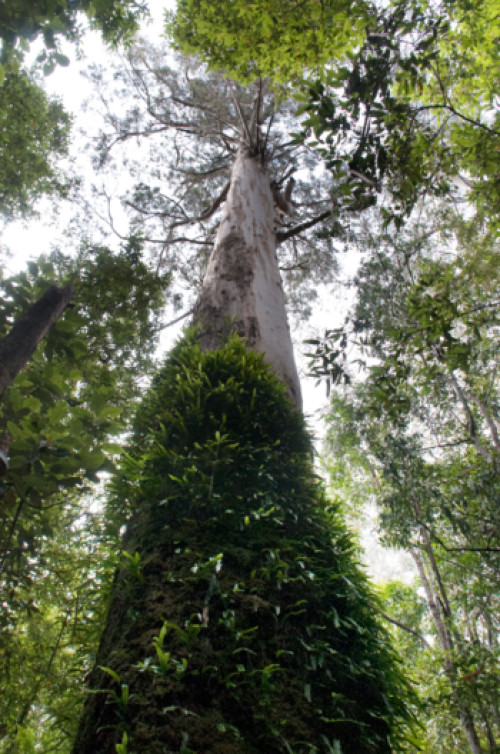What limits the height of trees? Is it the fraction of their photosynthetic energy they devote to productive new leaves? Or is it their ability to hoist water hundreds of feet into the air, supplying the green, solar-powered sugar factories in those leaves?
Both factors -- resource allocation and hydraulic limitation -- might play a role, and a scientific debate has arisen as to which factor (or what combination) actually sets maximum tree height, and how their relative importance varies in different parts of the world.
In research to be published in the journal Ecology -- and currently posted online as a preprint -- Thomas Givnish, a professor of botany at the University of Wisconsin-Madison, attempts to resolve this debate by studying how tree height, resource allocation and physiology vary with climate in Victoria state, located in southeastern Australia. There, Eucalyptus species exhibit almost the entire global range in height among flowering trees, from 4 feet to more than 300 feet.
"Since Galileo's time," Givnish says, "people have wondered what determines maximum tree height: 'Where are the tallest trees, and why are they so tall?' Our study talks about the kind of constraints that could limit maximum tree height, and how those constraints and maximum height vary with climate."
One of the species under study, Eucalyptus regnans -- called mountain ash in Australia, but distinct from the smaller and unrelated mountain ash found in the U.S. -- is the tallest flowering tree in the world. In Tasmania, an especially rainy part of southern Australia, the tallest living E. regnans is 330 feet tall. (The tallest tree in the world is a coastal redwood in northern California that soars 380 feet above the ground.)
Southern Victoria, Tasmania and northern California all share high rainfall, high humidity and low evaporation rates, underlining the importance of moisture supply to ultra-tall trees. But the new study by Givnish, Graham Farquhar of the Australian National University and others shows that rainfall alone cannot explain maximum tree height.
A second factor, evaporative demand, helps determine how far a given amount of rainfall will go toward meeting a tree's demands. Warm, dry and sunny conditions cause faster evaporation from leaves, and Givnish and his colleagues found a tight relationship between maximum tree height in old stands in Australia and the ratio of annual rainfall to evaporation. As that ratio increased, so did maximum tree height.
Other factors -- like soil fertility, the frequency of wildfires and length of the growing season -- also affect tree height. Tall, fast-growing trees access more sunlight and can capture more energy through photosynthesis. They are more obvious to pollinators, and have potential to outcompete other species.
"Infrastructure" -- things like wood and roots that are essential to growth but do not contribute to the production of energy through photosynthesis -- affect resource allocation, and can explain the importance of the ratio of moisture supply to evaporative demand.
"In moist areas, trees can allocate less to building roots," Givnish says. "Other things being equal, having lower overhead should allow them to achieve greater height.
"And plants in moist areas can achieve higher rates of photosynthesis, because they can open the stomata on their leaves that exchange gases with the atmosphere. When these trees intake more carbon dioxide, they can achieve greater height before their overhead exceeds their photosynthetic income."
The constraints on tree height imposed by resource allocation and hydraulics should both increase in drier areas. But Givnish and his team wanted to know the importance of each constraint.
The scientists examined the issue by measuring the isotopic composition of carbon in the wood along the intense rainfall gradient in their study zone. If hydraulic limitation alone were to set maximum tree height, the carbon isotope composition should not vary because all trees should grow up to the point at which hydraulics retards photosynthesis. The isotopic composition should also remain stable if resource allocation alone sets maximum height, because resource allocation does not directly affect the stomata.
But if both factors limit tree height, the heavier carbon isotopes should accumulate in moister areas where faster photosynthesis (enhanced by wide-open stomata) can balance the costs of building more wood in taller trees. Givnish, Farquhar and their colleagues found exactly that, implying that hydraulic limitation more strongly constrains maximum tree height under drier conditions, while resource allocation more strongly constrains height under moist conditions.
Most studies of tree height have focused on finding the tallest trees and explaining why they live where they do, Givnish says. "This study was the first to ask, 'How does the maximum tree height vary with the environment, and why?'"
University of Wisconsin-Madison. (2014, August 14). New analysis links tree height to climate. ScienceDaily. Retrieved August 18, 2014 from www.sciencedaily.com/releases/2014/08/140814191343.htm


